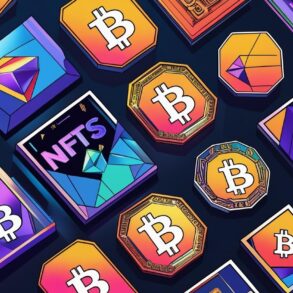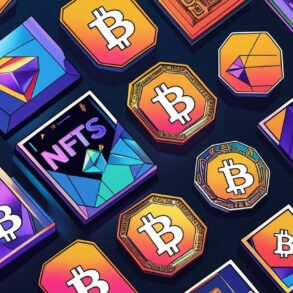
From record-breaking sales in 2021 to a major market cooldown and reduced transaction values in 2023. What’s happening in the NFT market?
The world of non-fungible tokens (NFTs) has seen dramatic ups and downs since they first appeared. NFTs started as an idea called “colored coins” on the Bitcoin (BTC) blockchain around 2012-2013. But their real moment in the spotlight came with the Ethereum (ETH) blockchain in 2017. Ethereum revolutionized how NFTs were created, stored, and traded, setting the stage for a new digital era.
Then, the year 2021 was a game-changer for NFTs, especially in the art world. Trading volumes in the NFT art market skyrocketed, reaching $13 billion. The sale of Beeple’s digital artwork for a staggering $69 million was a highlight, marking a new era in digital art.
Alongside, projects like CryptoPunks, CryptoKitties, and Bored Ape Yacht Club gained fame, shaping trends in digital art and collectibles. The term “NFT” became so popular that Collins Dictionary named it the Word of the Year in 2021.
Despite this surge in popularity, recent trends suggest a cooling off in the NFT market. As we delve into the latest data, we explore a crucial question: Were NFTs just a passing trend, or do they have a lasting impact?
The rise and ebb of the NFT market
The NFT market, after experiencing a remarkable surge in popularity and value through 2021 and early 2022, has seen a significant downturn as of Dec. 2023.
The decline became evident in late 2022, when transaction volumes for NFTs dropped sharply. OpenSea, the largest NFT marketplace, reported an 89% decrease in deal values between December 2021 and December 2022.
Even prominent auction houses like Sotheby’s scaled back their focus on NFTs despite a few high-profile sales.
This downward trend persisted into 2023. In the first quarter, transactions were worth $4.7 billion, which increased from $1.9 billion in the last few months—a steep drop from the $12.6 billion recorded in the same period of 2022.
Moreover, more than 50% of NFT sales during Q3 2022 occurred at less than $200, signaling a considerable shift from previous highs.
Despite these challenges, the NFT market hasn’t been entirely desolate. Some sales have persisted, though at lower frequencies and values.
For example, Christie’s digital platform, Christie’s 3.0, successfully auctioned an artwork for 50.1 ETH (around $93,000) in May 2023. Another noteworthy sale in June 2023 saw nearly $11 million exchanged for 40 digital artworks.
Data from Dune Analytics revealed a spike in trading volumes across major marketplaces, reaching a four-month high in Nov. 2023. Notably, Blur accounted for a substantial portion of these trades.
However, these figures pale in comparison to the early 2021 boom, when the market was driven by a strong FOMO (Fear of Missing Out) sentiment, with everyone eager to invest in NFTs for potential future gains.
NFT trends and highlights
According to a report from August 2023, NFT ownership in the U.S. stands at around 4%, a figure that doubled within a year. California was at the forefront of this trend. Despite this growth, a significant majority of the U.S. population (70%) remains unfamiliar with NFTs.
In stark contrast, Southeast Asian countries like the Philippines (32% ownership), Thailand (26.6%), and Malaysia (23.9%) have seen a substantial rise in NFT adoption, reflecting a wider acceptance and understanding of this technology in these regions.
The art segment of the NFT market, however, has experienced variable sales. Between April 2021 and April 2023, the number of sales fluctuated significantly, with total sales in April 2023 being around 7.7 thousand, a drastic decline from the peak in August 2021.
Moreover, the NFT market recorded its first-ever quarterly loss in Q3 2022, totaling over $450 million. Nonetheless, over 12% of affluent Asian consumers have engaged in NFT purchases.
Amid this, global interest in NFTs, as measured by Google search trends, has declined sharply since its peak in January 2022. This waning interest is also evident in the falling base prices of leading NFT collections.
For instance, the Doodles collection saw its base price drop by 90%, and its sales volume plunged from $53 million in April 2022 to just $2.4 million in April 2023.
Similarly, Moonbirds experienced a 94% decrease in base prices, with a corresponding drop in sales volume from $484 million to $3.1 million over the same timeframe.
On the brighter side, the integration of NFTs into the gaming industry has been notable, with major companies like Ubisoft and GameStop embracing the play-to-earn model, particularly in developing countries.
Additionally, the dynamics of the NFT market show considerable differences in interest and adoption across income levels and generations. Millennials, for instance, are three times more likely to engage with NFTs compared to Gen Z. In the U.S., 29% of adults have shown interest in NFT investing.
In Asia, especially in countries like China, Hong Kong, and Singapore, there is heightened online search interest in NFTs.
The Asia-Pacific region accounts for 43% of the global NFT market share, and the top five countries with the highest NFT adoption are also located in this region.
Reasons for decline in the NFT market
The following reasons collectively contributed to the decline in the NFT market:
Oversaturation of the market: The NFT market experienced a rapid expansion with a flood of new projects and collectibles. This led to a saturation of NFTs, diluting their value and contributing to a bubble mentality. The lack of scarcity and uniqueness diminished the perceived value of many NFTs, resulting in a drop in prices.
Speculative nature: Much of the NFT market was driven by speculation rather than genuine interest in the digital art or collectibles themselves. This speculative fervor led to inflated prices, and when the market sentiment turned negative, many investors rushed to exit, causing a sharp decline in NFT values.
Regulatory concerns: Governments and regulatory bodies around the world began scrutinizing NFTs more closely in 2022. This led to concerns among buyers and sellers about potential legal and tax implications, adding uncertainty to the market.
Lack of utility and environmental concerns: Many NFT projects faced criticism for lacking practical applications beyond collectibles, casting doubt on their lasting value. Additionally, the environmental concerns, particularly significant for NFTs on blockchain networks like Ethereum, stemmed from the high energy consumption required for blockchain transactions. Consequently, these environmental implications have caused some artists and collectors to reconsider their involvement with NFT technology.
Criticisms against NFTs
In his recent appearance on the “Joe Rogan Experience” podcast, Elon Musk, CEO of Tesla and SpaceX, shared his insights on the state of NFTs.
Musk highlighted a significant issue with many NFTs: their reliance on external servers rather than full storage on the blockchain. He expressed concern that this structure, where NFTs often serve as mere links to JPEG images on external servers, could lead to loss of access if those hosting companies cease operations.
To mitigate these risks, Musk suggested that embedding the actual JPEG or artwork directly within the blockchain would be a more secure and reliable approach.
Musk’s observations have found particular resonance among Bitcoin enthusiasts. They advocate for the Bitcoin Ordinals protocol, which inscribes artwork and media directly onto the Bitcoin blockchain. According to them, this ensures the longevity of these digital assets as long as the Bitcoin network remains active, offering a stark contrast to Ethereum’s more centralized approach.
However, the Ordinals protocol is not without its challenges. It raises questions about the scalability and efficiency of storing large data directly on the Bitcoin blockchain, potentially leading to increased transaction fees and network congestion.
Future of NFTs: will they recover?
NFTs’ potential for recovery and future growth lies in their expanding applications and evolving market dynamics.
The NFT market is currently diversifying beyond its initial focus on digital art. This expansion includes sectors like decentralized finance (defi) and gaming, where NFTs are increasingly used as collateral for crypto loans and integrated into play-to-earn (P2E) gaming models.
Moreover, NFTs are making inroads into various realms such as film, sports, fashion, virtual worlds, ticket sales, and supply chain management.
This diversification is driven by big brands, following in the footsteps of early adopters like Reddit and Nike, who leveraged NFTs to boost customer engagement.
In terms of market growth, the outlook appears decent. Analysts predict that the NFT market could reach a valuation of $3.3 billion by 2027, growing at a compound annual growth rate (CAGR) of 18.55%.
To sum up, the NFT market is in a phase of transition and maturation. Its expansion into diverse sectors, coupled with technological advancements and efforts to address environmental concerns, positions it for a potential resurgence in relevance and growth.
This post was originally published on this site be sure to check out more of their content








